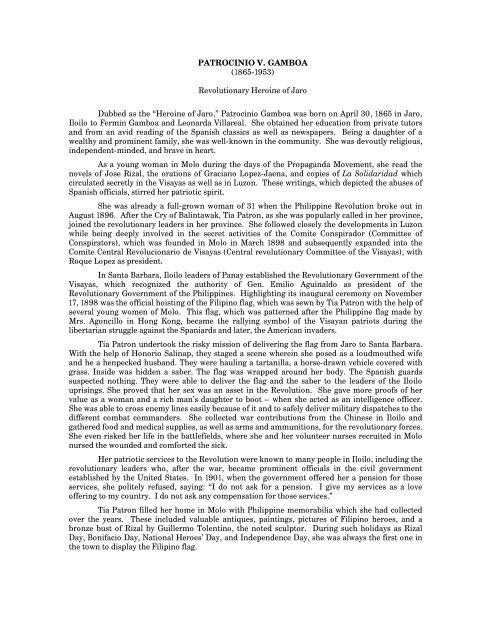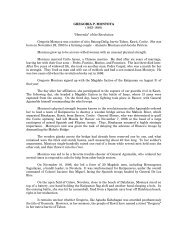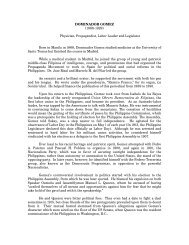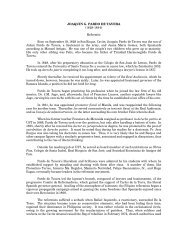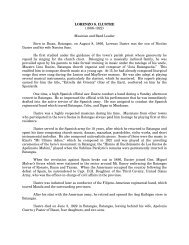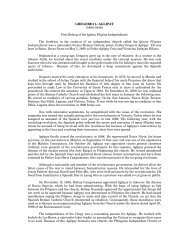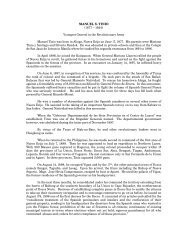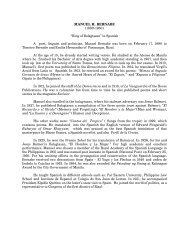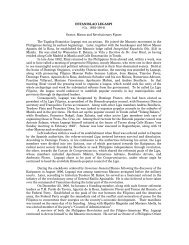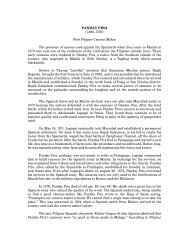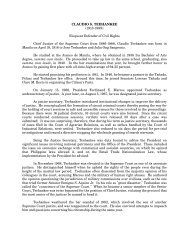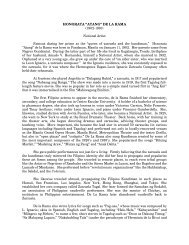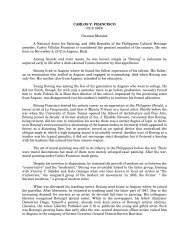Patrocinio Gamboa was born o - National Historical Commission of ...
Patrocinio Gamboa was born o - National Historical Commission of ...
Patrocinio Gamboa was born o - National Historical Commission of ...
Create successful ePaper yourself
Turn your PDF publications into a flip-book with our unique Google optimized e-Paper software.
PATROCINIO V. GAMBOA<br />
(1865-1953)<br />
Revolutionary Heroine <strong>of</strong> Jaro<br />
Dubbed as the “Heroine <strong>of</strong> Jaro,” <strong>Patrocinio</strong> <strong>Gamboa</strong> <strong>was</strong> <strong>born</strong> on April 30, 1865 in Jaro,<br />
Iloilo to Fermin <strong>Gamboa</strong> and Leonarda Villareal. She obtained her education from private tutors<br />
and from an avid reading <strong>of</strong> the Spanish classics as well as newspapers. Being a daughter <strong>of</strong> a<br />
wealthy and prominent family, she <strong>was</strong> well-known in the community. She <strong>was</strong> devoutly religious,<br />
independent-minded, and brave in heart.<br />
As a young woman in Molo during the days <strong>of</strong> the Propaganda Movement, she read the<br />
novels <strong>of</strong> Jose Rizal, the orations <strong>of</strong> Graciano Lopez-Jaena, and copies <strong>of</strong> La Solidaridad which<br />
circulated secretly in the Visayas as well as in Luzon. These writings, which depicted the abuses <strong>of</strong><br />
Spanish <strong>of</strong>ficials, stirred her patriotic spirit.<br />
She <strong>was</strong> already a full-grown woman <strong>of</strong> 31 when the Philippine Revolution broke out in<br />
August 1896. After the Cry <strong>of</strong> Balintawak, Tia Patron, as she <strong>was</strong> popularly called in her province,<br />
joined the revolutionary leaders in her province. She followed closely the developments in Luzon<br />
while being deeply involved in the secret activities <strong>of</strong> the Comite Conspirador (Committee <strong>of</strong><br />
Conspirators), which <strong>was</strong> founded in Molo in March 1898 and subsequently expanded into the<br />
Comite Central Revolucionario de Visayas (Central revolutionary Committee <strong>of</strong> the Visayas), with<br />
Roque Lopez as president.<br />
In Santa Barbara, Iloilo leaders <strong>of</strong> Panay established the Revolutionary Government <strong>of</strong> the<br />
Visayas, which recognized the authority <strong>of</strong> Gen. Emilio Aguinaldo as president <strong>of</strong> the<br />
Revolutionary Government <strong>of</strong> the Philippines. Highlighting its inaugural ceremony on November<br />
17, 1898 <strong>was</strong> the <strong>of</strong>ficial hoisting <strong>of</strong> the Filipino flag, which <strong>was</strong> sewn by Tia Patron with the help <strong>of</strong><br />
several young women <strong>of</strong> Molo. This flag, which <strong>was</strong> patterned after the Philippine flag made by<br />
Mrs. Agoncillo in Hong Kong, became the rallying symbol <strong>of</strong> the Visayan patriots during the<br />
libertarian struggle against the Spaniards and later, the American invaders.<br />
Tia Patron undertook the risky mission <strong>of</strong> delivering the flag from Jaro to Santa Barbara.<br />
With the help <strong>of</strong> Honorio Salinap, they staged a scene wherein she posed as a loudmouthed wife<br />
and he a henpecked husband. They were hauling a tartanilla, a horse-drawn vehicle covered with<br />
grass. Inside <strong>was</strong> hidden a saber. The flag <strong>was</strong> wrapped around her body. The Spanish guards<br />
suspected nothing. They were able to deliver the flag and the saber to the leaders <strong>of</strong> the Iloilo<br />
uprisings. She proved that her sex <strong>was</strong> an asset in the Revolution. She gave more pro<strong>of</strong>s <strong>of</strong> her<br />
value as a woman and a rich man’s daughter to boot – when she acted as an intelligence <strong>of</strong>ficer.<br />
She <strong>was</strong> able to cross enemy lines easily because <strong>of</strong> it and to safely deliver military dispatches to the<br />
different combat commanders. She collected war contributions from the Chinese in Iloilo and<br />
gathered food and medical supplies, as well as arms and ammunitions, for the revolutionary forces.<br />
She even risked her life in the battlefields, where she and her volunteer nurses recruited in Molo<br />
nursed the wounded and comforted the sick.<br />
Her patriotic services to the Revolution were known to many people in Iloilo, including the<br />
revolutionary leaders who, after the war, became prominent <strong>of</strong>ficials in the civil government<br />
established by the United States. In 1901, when the government <strong>of</strong>fered her a pension for those<br />
services, she politely refused, saying: “I do not ask for a pension. I give my services as a love<br />
<strong>of</strong>fering to my country. I do not ask any compensation for those services.”<br />
Tia Patron filled her home in Molo with Philippine memorabilia which she had collected<br />
over the years. These included valuable antiques, paintings, pictures <strong>of</strong> Filipino heroes, and a<br />
bronze bust <strong>of</strong> Rizal by Guillermo Tolentino, the noted sculptor. During such holidays as Rizal<br />
Day, Bonifacio Day, <strong>National</strong> Heroes’ Day, and Independence Day, she <strong>was</strong> always the first one in<br />
the town to display the Filipino flag.
She remained single up to her death on November 24, 1953. She <strong>was</strong> buried with military<br />
honors at the Balantang Veteran’s Cemetery in Jaro.<br />
In her honor, a marker <strong>was</strong> installed in Jaro, Iloilo on December 21, 1980.<br />
References:<br />
Ancheta, Herminia M. and Michaela Beltran-Gonzales, Filipino Women in Nation Building,<br />
Phoenix Publishing House Inc., Quezon City, 1984.<br />
Sonza, Demy P. Illustrious Ilonggos Volume I, Iloilo Provincial <strong>Historical</strong> Committee, Iloilo<br />
City, 1972.<br />
Quirino, Carlos. Who’s Who in Philippine History. Manila: Tahanan Books, 1995.<br />
Zaide, Gregorio Great Filipinos in History, Manila, 1970.


